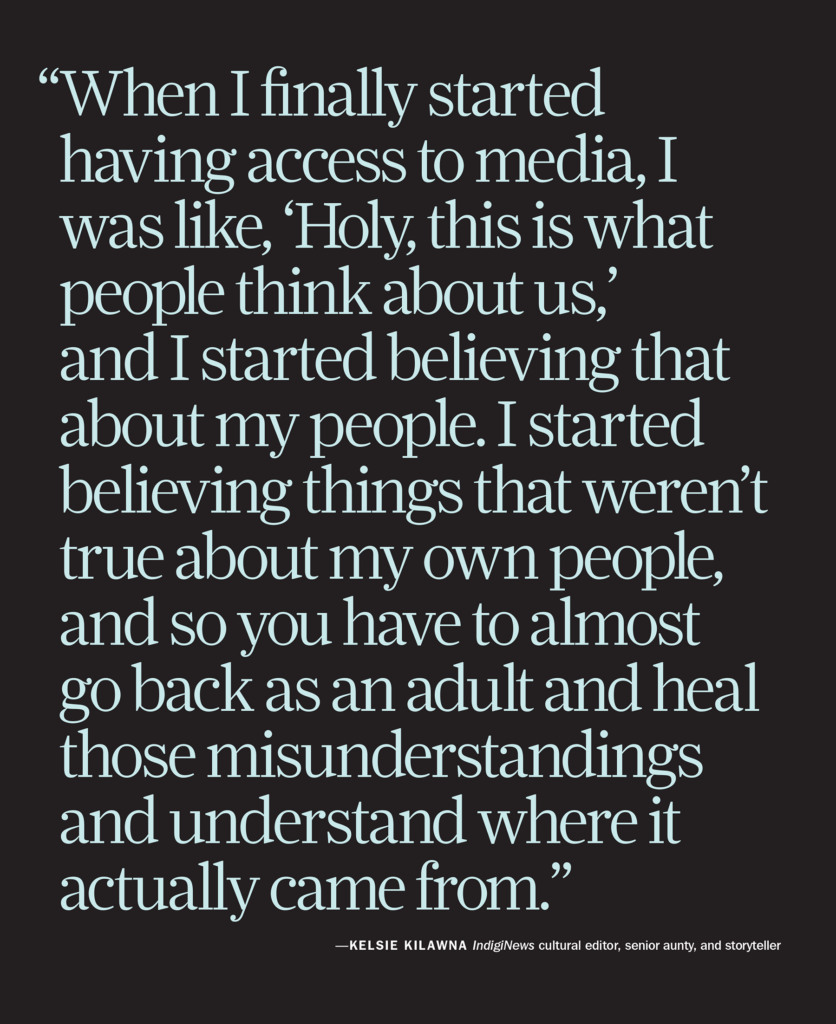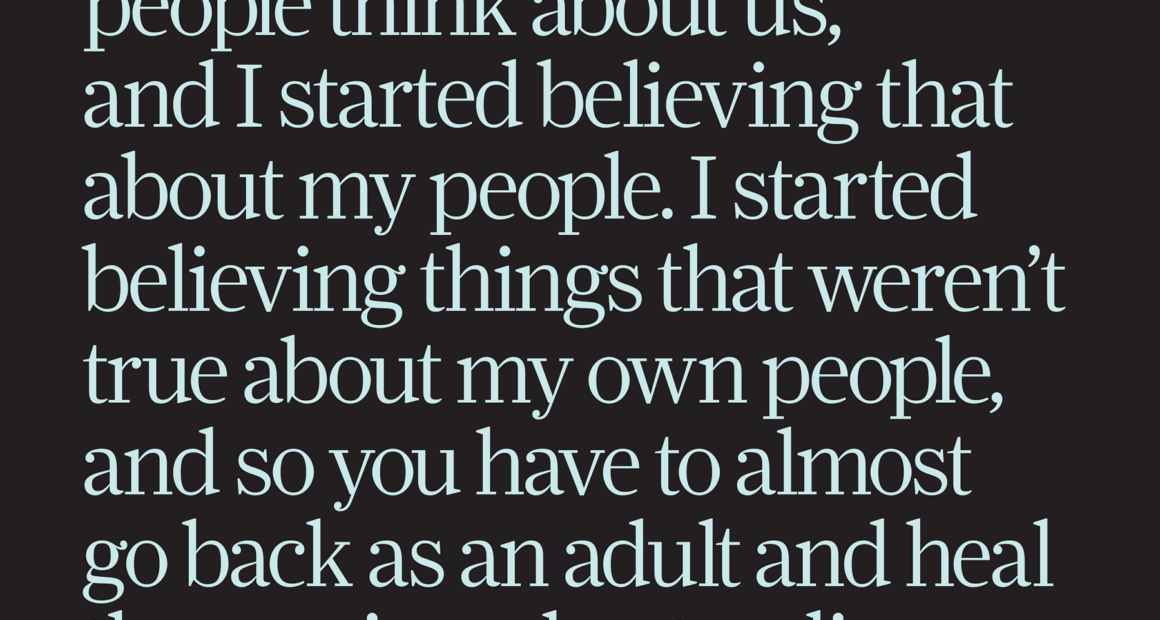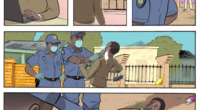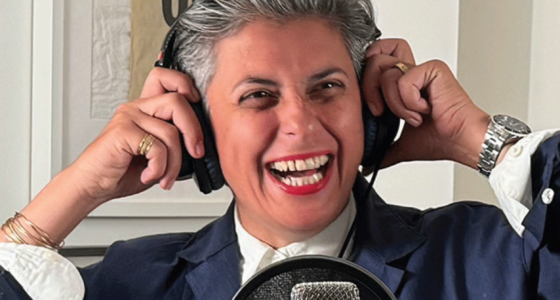More work still needs to be done by journalists in Canada to accurately report on diverse communities

Editors’ Note: Kelsie Kilawna’s first name is used throughout the piece in recognition of the harmful association of the dehumanizing use of last names in state-sanctioned residential schools across Canada.
When news broke in May 2021 that the remains of 215 Indigenous children had been discovered at an unmarked burial site at the former Kamloops Indian Residential School, located on the Tk’emlúps te Secwépemc First Nation in British Columbia, Canadian news publications leapt on the story. The discovery, after all, had developed into a national story of shock and shame over the horrors of the former state-enforced residential school system. As news media rushed to the site of a ceremony to mark the grave moment, the team at IndigiNews decided to remain silent and honour Secwépemc funeral grieving instead. Kelsie Kilawna, the independent news outlet’s cultural editor and senior aunty, was there to support her family, who, she tweeted, are survivors of the residential school. Her publication has been covering issues affecting Indigenous communities in the Okanagan Valley and Vancouver Island with particular care, staying away from the stereotypical portrayal of Indigenous Peoples in the news.
At the ceremony honouring the victims at the Kamloops burial site, she observed as an elder pleaded with reporters to turn off their cameras and recorders. “We’re not your daily news,” she recalled the elder saying. Kelsie was concerned the coverage would exploit those at the heart of the story, for whom the moment of acknowledgement was both personal and traumatic. She also recalled that only one reporter heeded the elder’s request and put their camera down. There were other moments of disrespect as well. She shared her observations on Twitter. “I was supporting my family who are survivors outside the Kamloops IR ‘school,’ now memorial & saw reporters flock, saw them stopping survivors for a photo-op and in general taking up way too much space. U know you can still do good work without making it about you.” Frustrated with and ashamed of the journalism industry, she wrote, “So much dismantling of media needs to be done.”
In their book Seeing Red: A History of Natives in Canadian Newspapers, published in 2011, authors Mark Cronlund Anderson and Carmen L. Robertson documented, in some detail, the consistent ways in which coverage of Indigenous communities in English publications reflects how colonial legal and cultural structures have misrepresented and maligned communities since 1869. More geographically focused studies, like Crystal Maslin’s 2002 master’s thesis on coverage of Indigenous people in print media in Saskatchewan, titled “A Social Construction of Aboriginal Peoples in the Saskatchewan Print Media,” have cemented this. Maslin did a content analysis of 437 articles published in the Regina Leader-Post and the Saskatoon StarPhoenix. This revealed that 42 percent referenced Aboriginal Peoples in a negative way. She divided these portrayals into categories, including: “the ‘troublemaker,’ the ‘crook’ and the ‘criminal,’” all of which accounted for 55 percent of 56 front-page news stories mentioning Aboriginal Peoples.
CBC’s Duncan McCue has advocated against the stereotypical focus of Indigenous community narratives in media stories, which are drumming, dancing, drunk, or dead. Elements of Indigenous Style: A Guide for Writing By and About Indigenous Peoples by Gregory Younging provides excellent context and tools for reporting, as do numerous reports from Journalists for Human Rights. Consequently, organizations like the Canadian Association for Black Journalists (CABJ) and journalists alike have begun to publicly point out the longstanding hypocrisy in the application of journalistic standards and principles. Yet, despite prompts relating specifically to the practice of journalism in national documents, including the Truth and Reconciliation Commission of Canada’s calls to action numbers 84, 85, and 86, reporters like Kelsie have to endure coverage practices that reflect a failure to truly listen. “There’s no integrity that I see. I see something here and there with specific journalists. But I don’t see any overhaul of the media right now,” she says. “I see journalists doing their best, I see journalists trying to break barriers within their own organizations. But I don’t see the outlet as a whole making commitments and I don’t see them enacting Truth and Reconciliation as wholeheartedly as they could.”
Representation is one step in a complex effort at inclusion, and the history of transparency in the effort to understand who staffs media organizations is questionable. One of the first concrete data sets emerged this year when the Canadian Association of Journalists (CAJ) released its diversity survey. In 2010, academics at X University published “Diversity in Leadership and Media: A Multi-Perspective Analysis of the Greater Toronto Area,” a study shedding light on the representation of minorities in Canadian news. It estimated that within the following 21 years, the population of Toronto could see a 63 percent uptick in visible minorities. In 2016, 52 percent of people in Toronto identified as “visible minorities”—Statistics Canada’s term for racialized people—which does not include Indigenous populations. This is a 47 percent increase from 2006. “Data showed that visible minorities were significantly under-represented in leadership positions, accounting for only 14 percent of leaders, compared to 49.5 percent of the general population under study,” the report reads. Visible minorities were also found to be underrepresented among newspaper columnists and as hosts and experts on suppertime broadcasts, they concluded. The CAJ 2021 Canadian Newsroom Diversity Survey showed that out of 209 newsrooms and 3,873 journalists, 75 percent of all staff identify as white. What impact does a lack of representation have on communities that are covered and how does it affect the public’s trust in news organizations?
For Kelsie, the experience was extremely difficult. “When I finally started having access to media, I was like, ‘Holy, this is what people think about us,’ and I started believing that about my people. I started believing things that weren’t true about my own people, and so you have to almost go back as an adult and heal those misunderstandings and understand where it actually came from.” The experience of misrepresentation is not limited to Indigenous communities, but all those who find themselves on the margins of the dominant white narrative. What options, then, do those who push for trauma-informed reporting on critical human-interest stories have as they continue to have faith in the practice of journalism? Anger spilled onto the streets all over the world in May 2020 after news broke of the police murder of a Black man named George Floyd. That racial reckoning helped push the needle on news coverage to some extent, and by June 2020, amid a newfound racial consciousness, organizations, politicians, and media critics alike were calling for changes to be made to Canadian media to address the underrepresentation of Black journalists in the industry.
But even before the protests in the spring, in January 2020 the CABJ and the CAJ had drafted seven calls to action, outlining what newsrooms can do to create a more diverse space. At the core, however, their document stated that the industry’s approach toward racial inequities needs to change if it wants to have a meaningful impact. Some changes the document noted include formally consulting with racialized communities about news coverage on an ongoing basis and taking a structural approach to improving representation beyond corporate training and workshops. Selam Debs, an anti-oppression educator and cofounder of The Anti-Racism Community Collective in Ontario, says the problem is that the industry isn’t diverse. “[It] doesn’t actually reflect back society. [Instead], it writes a narrative and a story based on who is doing the writing—and let’s be honest, the people that are often doing the writing are white folks. Because the media industry is so quick and fast and needs stories, it perpetuates this ongoing kind of train of anti-Black and anti-Indigenous racism.” Many journalists on deadline use police press releases as a basis for their reporting, which can be problematic. In the original press release about George Floyd’s murder, Minneapolis police said he “appeared to be suffering medical distress” after he was arrested. Reporting based on that information would not have given an accurate picture of how Floyd died. “For Black and Indigenous [people], they are often seen as the other and therefore are often tokenized,” says Debs. That’s why, she stresses, as journalists, we need to think about “whose voices are being centred.”
Racialized reporters often bear the brunt of this experience. As a Black journalist, Matthew DiMera has spent much of his career as the managing editor at Xtra and interim editor-in-chief at Rabble trying to change institutions from within by shifting how newsrooms report on communities of colour. Despite every small effort he has undertaken—altering the language that’s used to refer to racialized communities and mandating more diversity in sources—he realized that all the energy that’s been sunk into change made very little progress. “I did internships in some bigger places and I did some work in television as well, and it became really clear to me that I felt like I was going to have a much harder time in some of those places,” he says. “Whether that was really true or not is a different thing, but the feeling I got in a lot of those spaces was that there would have to be a lot of compromises for me to exist in those spaces. So, I worked mostly in independent media,” he says. “We’re looking for a capital ‘R’ racism, right? Someone calling someone the n-word, we can all agree that’s racist.” He goes on to explain how there are differences in the way a Black source is covered in a story in comparison to a white source. Though it might be subtle, it’s still present. “It’s not necessarily a capital ‘R’ glaring example,” he continues. “It’s cumulative and it is, in fact, in many ways, probably a lot more dehumanizing because it can be subtle to the point that it’s invisible, and so the reporters may not be aware they’re doing it. The sources are so used to it that they’re not necessarily going to stop the interview either.”
“It is, in fact, in many ways, probably a lot more dehumanizing because it can be subtle to the point that it’s invisible”
According to the 2021 Edelman Trust Barometer, which is a trust survey created to inform leadership and policy across institutions, 52 percent of Canadians, based on an online survey of 33,000 respondents—1,150 of which were Canadian—found that “the media is not doing well at being objective and non-partisan.” To understand why this is happening, we need to speak to people who express skepticism about the work journalists do. Amy Smoke (Mohawk Nation and Turtle Clan) and Bangishimo Johnston (Anishinaabe, originally Couchiching), TwoSpirit IndigiQueers, felt their voices and narratives were misconstrued when media covered the start of O:se Kenhionhata:tie, also known as Land Back Camp, in Kitchener, Ontario’s Victoria Park, in June 2020. “The start of Land Back Camp was a direct result of the health disparities, and murders of Black, Indigenous, and racialized folks during the first lockdown in March of 2020, and we set up the tipi to bring awareness to Land Back and all of the things COVID had been bringing to light,” says Smoke. On several occasions, they say, media stories framed them in a harmful manner. Because of this, Johnston explains, “We have our own little mental list of reporters who we won’t talk to at all. I’ll never talk to them again because they’ve taken quotes out of context or they would interview with us, but then [the story was] written from the other perspective and written against the camp versus writing from a space that supports the camp. Or even a lot of tokenizing; there’s a lot of whitewashing in our stories.”
Coverage without consideration of the impact on sources, however, is increasingly problematic for newsrooms in a growing period of mistrust and distrust of media organizations. Julie Sobowale, the interim executive director of the CABJ, strongly believes that we need to begin rebuilding and fostering trust with our sources. “I think we need to look at journalism in terms of trust. If our audience doesn’t trust us, our reporting will not have the effect we are looking for, and again this comes to the deep-rooted principles of journalism. We’re not just here to inform or be more accurate or to be objective; we want to make an impact,” she says. “If our audience does not trust us, then really, we are not having the effect we are looking for. You have to have representation. This is a multiethnic, multicultural, multilinguistic community that is Canada. You can’t get away with not having representation.” In turn, the lack of trust has created a reluctance within communities when it comes to wanting to speak to journalists, which is what Smoke and Johnston have gone through first-hand.
“This is a multiethnic, multicultural, multilinguistic community that is Canada. You can’t get away with not having representation”
Writing from the “traditional” white-dominant perspective can alienate some communities, says Sobowale. “This is the big journalism issue. When we do stuff like that systemically, communities don’t want to talk to us, and as individual journalists, we have to understand that.” Sobowale further elaborates on how crucial it is while you are in the initial stages of seeking out someone to speak to, to keep a relationship with them and take the time to listen. “We should not say that the communities don’t talk to us or they’re not open to us, so I can’t report on the story. That’s not fair for the community, because people have not told their story in a way that actually reflects their principles,” she says. Yet how can newsrooms begin to reflect their principles when those who are telling the stories largely come from a white background? Smoke and Johnston note that sometimes the journalists who are sent to cover the story are racialized, but that doesn’t solve the problem. “If the trust has been broken, is that the solution?” DiMera, too, finds some of the efforts superficial. “Solutions are deeper and require bigger fixes than most newsrooms are willing or interested in doing,” he says. His experiences in newsrooms made him believe proper steps weren’t being taken to address systemic racism. “[Publishers and editors] are willing to issue public statements, but not willing to actually change anything substantial,” he says.
Shifts have been made within legacy media organizations, with the creation of leadership positions for Black and Indigenous journalists. Some examples are Tamika Forrester, producer of CBC’s Being Black in Canada, and Kelly Boutsalis, who announced in a tweet that she was the lead producer at CBC’s Six Nations bureau, a project that ran between November 2021 and March 2022 to give Indigenous journalists a platform to report on the Six Nations communities. Alternatively, some media organizations have incorporated a section on their sites that house specific voices—for example, Global News’ Perspectives section. But for many journalists, the answer lies in creating new spaces and exploring new frontiers of journalistic practice. It’s why DiMera has set about establishing The Resolve, an effort to shift the “traditional” journalistic narrative, celebrating and centralizing BIPOC voices. Though the independent media outlet has recently launched, many people have donated to get the project on its feet, demonstrating a collective desire from the public to see new narratives brought to the table. These, he argues, must be concentrated on communities. “It can’t just be when a big story comes out,” he says. “These have to be sustained, they have to be long term, and they have to be sincere.”
Meaningful representation with a voice that is heard at the story table can go a long way toward building a strong future for journalists’ relationships with communities. Despite their own experiences and because of the work they now do, both Kelsie and DiMera feel strongly about the power of their chosen profession. “I think journalism can be a really beautiful and powerful thing when done well,” says DiMera. “But when done poorly, it’s a very dangerous thing.” The big picture is important to remember, offers Kelsie. “There’s so much in the way of our ability to shift the narrative, but it’s not just about shifting the narrative for Indigenous people or any BIPOC person. What this is about is life preservation.”




